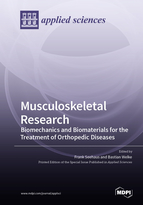Musculoskeletal Research: Biomechanics and Biomaterials for the Treatment of Orthopedic Diseases
A special issue of Applied Sciences (ISSN 2076-3417). This special issue belongs to the section "Materials Science and Engineering".
Deadline for manuscript submissions: closed (15 May 2022) | Viewed by 44405
Special Issue Editors
Interests: clinical biomechanics, orthopedic surgery, clinical trials, and bioengineering; roentgen stereophotogrammetric analysis; motion analysis; biomechanics; bone; total joint arthroplasty; in vivo kinematics; fracture; sports injuries
Interests: biomechanics; kinematics; biomechanical engineering; mechanical properties; fracture; motion analysis; composites; posture; gait analysis; arthroplasty
Special Issue Information
Dear Colleagues,
Musculoskeletal research deals with the effects of orthopedic treatment of pathologies on the biomechanics of the affected areas and on the musculoskeletal system. Biomechanical measurement methods enable the quantitative determination of these influences and allow an assessment of their extent and size for the patient (in vivo).
The range of examination methods is particularly wide in this field of musculoskeletal research. On one hand, in vitro examinations under laboratory conditions on simplified models, such as artificial bones or specimens from donors, will be implemented. With the help of these models, for example, new biomaterials or implants for the treatment of fractures are often examined for their primary stability or the influence of a joint replacement on the kinematics. In contrast to experimental in vitro studies, numerical methods will be increasingly applied to analyze a large number of implant configurations and loading scenarios. With the method of clinical motion analysis, a comprehensive view of the musculoskeletal system is performed directly in vivo on the patient. For example, it allows the monitoring and control of therapeutic interventions.
However, it is of great relevance to know the limits and possibilities of the applied methodology in its preclinical and clinical application. In order to be able to reliable answer clinical questions on orthopedic interventions, established and extensively validated methods and measurement protocols are the only means of choice.
These are just a few examples from the field of musculoskeletal research and its methods. They all have the common goal of increasing patient safety. This Special Issue intends to provide the reader with an exciting overview of current research in the field of biomechanical investigations for the treatment of musculoskeletal diseases.
We hope you enjoy reading it,
Dr. Frank Seehaus
Dr. Bastian Welke
Guest Editors
Manuscript Submission Information
Manuscripts should be submitted online at www.mdpi.com by registering and logging in to this website. Once you are registered, click here to go to the submission form. Manuscripts can be submitted until the deadline. All submissions that pass pre-check are peer-reviewed. Accepted papers will be published continuously in the journal (as soon as accepted) and will be listed together on the special issue website. Research articles, review articles as well as short communications are invited. For planned papers, a title and short abstract (about 100 words) can be sent to the Editorial Office for announcement on this website.
Submitted manuscripts should not have been published previously, nor be under consideration for publication elsewhere (except conference proceedings papers). All manuscripts are thoroughly refereed through a single-blind peer-review process. A guide for authors and other relevant information for submission of manuscripts is available on the Instructions for Authors page. Applied Sciences is an international peer-reviewed open access semimonthly journal published by MDPI.
Please visit the Instructions for Authors page before submitting a manuscript. The Article Processing Charge (APC) for publication in this open access journal is 2400 CHF (Swiss Francs). Submitted papers should be well formatted and use good English. Authors may use MDPI's English editing service prior to publication or during author revisions.
Keywords
- Tissue biomechanics
- In vivo diagnostics
- Numerical simulation
- Tribology
- Experimental biomechanics
- Joint kinematics
- Implant fixation
- Implant safety
- Motion/gait analysis







